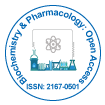
Biochemistry & Pharmacology: Open Access
Open Access
ISSN: 2167-0501
+44-77-2385-9429

ISSN: 2167-0501
+44-77-2385-9429
Commentary - (2024)Volume 13, Issue 1
Chemotherapeutic resistance in cancer cells is a complex issue resulting from many metabolic pathways. One of the primary mechanisms by which cancer cells develop resistance is through drug efflux, which involves the active transport of chemotherapeutic agents out of the cell, thereby reducing their intracellular concentrations and effectiveness. This process is largely mediated by ATP-Binding Cassette (ABC) transporters. Among these, Pglycoprotein (P-gp), also known as MDR1 (Multidrug Resistance Protein 1) is one of the most studied. These transporters use ATP hydrolysis to pump drugs out of the cells, effectively reducing the intracellular drug concentration to sub-lethal levels. Other notable ABC transporters include MRP1 and BCRP (Breast Cancer Resistance Protein).
Cancer cells can also develop resistance through the metabolic inactivation of chemotherapeutic drugs. This can occur via increased expression or activity of enzymes that detoxify the drug. For example, the enzyme Glutathione S-Transferase (GST) can combine drugs with glutathione, leading to their detoxification and subsequent excretion. Similarly, the enzyme aldehyde dehydrogenase can oxidize aldehydes produced by certain chemotherapeutic agents, thereby neutralizing their cytotoxic effects.
Alterations in the drug target can significantly contribute to chemotherapeutic resistance. These changes can occur through mutations in the genes encoding the target proteins, which reduce the binding affinity of the drugs. For instance, mutations in the beta-tubulin gene can confer resistance to taxanes, a class of chemotherapeutic agents that target microtubules. Additionally, cancer cells can overexpress the target proteins, necessitating higher drug concentrations to achieve the same therapeutic effect. Enhanced DNA repair capabilities are another critical factor in chemotherapeutic resistance. Many chemotherapeutic agents work by inducing DNA damage, leading to cell death. However, cancer cells can upregulate DNA repair pathways, allowing them to survive and proliferate despite the presence of DNA-damaging agents. Key DNA repair pathways involved in resistance include Nucleotide Excision Repair (NER), Base Excision Repair (BER), and Homologous Recombination (HR).
Resistance to chemotherapy often involves the evasion of apoptosis, the programmed cell death pathway that is a common outcome of effective chemotherapeutic treatment. Cancer cells can achieve this through several mechanisms. One common strategy is the overexpression of anti-apoptotic proteins such as Bcl-2 and Bcl-xL, which can inhibit the mitochondrial pathway of apoptosis. Additionally, mutations in pro-apoptotic genes such as p53 can impair the apoptotic response. Since p53 plays an important role in the response to DNA damage, its inactivation can lead to resistance against a wide range of chemotherapeutic agents. Autophagy is a cellular degradation pathway that can promote survival under stress conditions, including exposure to chemotherapeutic drugs. While autophagy can sometimes lead to cell death, it more commonly serves as a protective mechanism that enables cancer cells to survive chemotherapy. During autophagy, cellular components are sequestered in autophagosomes and degraded in lysosomes, recycling nutrients and removing damaged organelles. Upregulation of autophagy can help cancer cells withstand the metabolic and oxidative stress induced by chemotherapy.
The process of Epithelial-Mesenchymal Transition (EMT) has been implicated in the development of chemotherapeutic resistance. EMT is a cellular program through which epithelial cells acquire mesenchymal properties, including increased motility and invasiveness. This transition is associated with changes in gene expression that can contribute to drug resistance. A specific type of cancer cells known as Cancer Stem Cells (CSCs) have characteristics similar to those of stem cells, such as the capacity to self-renew and develop. CSCs play a significant role in chemotherapeutic resistance. These cells often exhibit increased expression of drug efflux pumps, enhanced DNA repair capabilities, and a heightened ability to activate survival pathways. Additionally, CSCs are typically quiescent, which makes them less susceptible to chemotherapeutic agents that target rapidly dividing cells.
Citation: Honjio T (2024) The Role of MGMT in DNA Repair and Resistance to Alkylating Agents in Cancer Treatment. Biochem Pharmacol.13:346.
Received: 19-Feb-2024, Manuscript No. BCPC-24-32565; Editor assigned: 22-Feb-2024, Pre QC No. BCPC-24-32565 (PQ); Reviewed: 08-Mar-2024, QC No. BCPC-24-32565; Revised: 15-Mar-2024, Manuscript No. BCPC-24-32565 (R); Published: 22-Mar-2024 , DOI: 10.35248/2167-0501.24.13.346
Copyright: © 2024 Honjio T. This is an open-access article distributed under the terms of the Creative Commons Attribution License, which permits unrestricted use, distribution, and reproduction in any medium, provided the original author and source are credited.